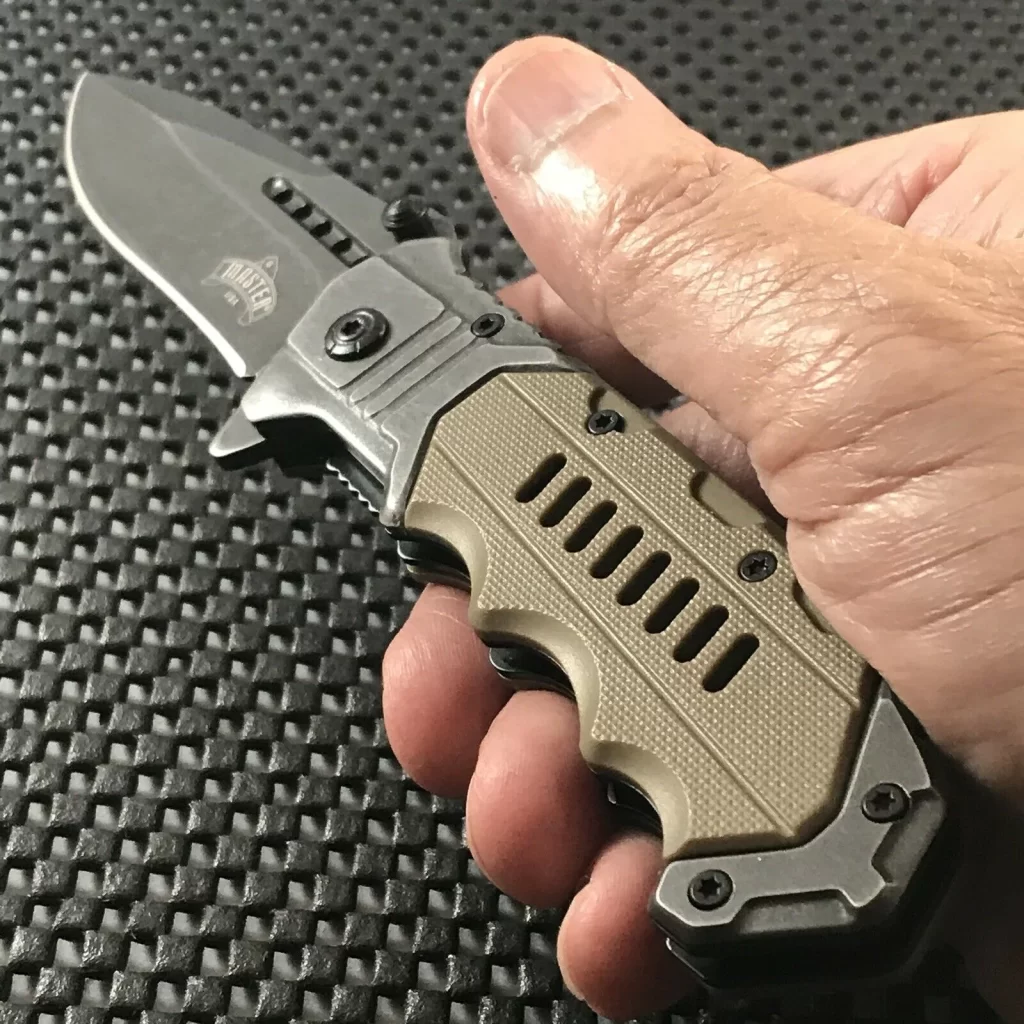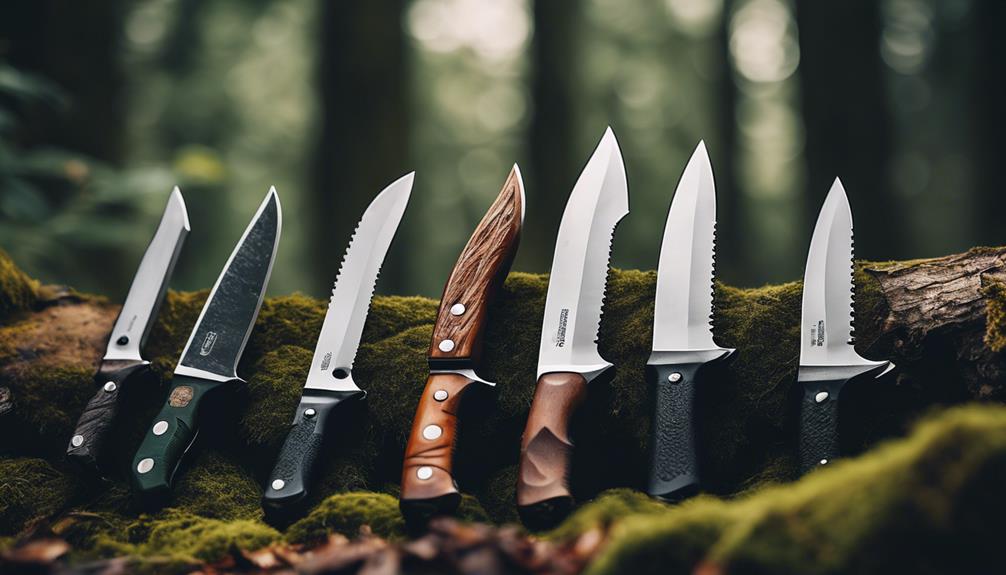
Brainstorm Security Shop

For Orders Over $199

On Any Of Our Products

Details On Refund Page
As you plan your next camping trip, consider the crucial role that a quality knife plays in your outdoor gear. Whether you’re slicing through tough material to set up camp or preparing a meal by the fireside, the right knife is more than just a tool—it’s your partner in the wilderness. With numerous options available, from stainless steel to carbon blades, and ergonomic handles designed for comfort and safety, selecting the perfect knife can be daunting. Yet, understanding these choices can significantly enhance your camping experience. Curious about which features will best suit your outdoor lifestyle? Let’s explore the key considerations.
A high-quality knife ensures you can confidently tackle various tasks while camping. Whether you’re slicing through tough rope, preparing food, or making kindling, the right knife makes all the difference. You’ll find that a durable, well-crafted knife not only performs better but also lasts longer, even under harsh outdoor conditions.
You’ve probably faced situations where a poor-quality knife failed you right when you needed it most. It can be frustrating and potentially dangerous. That’s why investing in a quality knife is crucial. It provides reliability and safety, key factors when you’re miles away from help.
A good knife holds its edge longer, meaning you won’t have to sharpen it as frequently. This saves you time and effort, letting you focus more on enjoying your adventure rather than maintaining your gear.
Moreover, a quality knife offers better ergonomics, which is essential for handling comfort and efficiency. You’re less likely to get blisters or feel fatigued after continuous use.

Understanding different blade materials will help you choose the best knife for your camping needs. The most common types you’ll encounter are stainless steel and carbon steel. Stainless steel is highly resistant to rust, making it ideal if you’re camping in damp or coastal environments. It’s less likely to corrode, so you won’t have to worry about maintenance as much. However, it’s typically harder to sharpen compared to carbon steel.
On the other hand, carbon steel is renowned for its durability and ease of sharpening. It holds an edge longer than stainless steel, which means you can rely on it for consistent cutting performance during your trip. But, it’s more prone to rust, so you’ll need to keep it dry and occasionally oil it to maintain its condition.
Another option you might come across is high-carbon stainless steel, which combines the best of both worlds. It’s easier to sharpen than regular stainless steel and more resistant to rust than plain carbon steel.
Choosing the right blade material depends on your specific camping activities and how much maintenance you’re willing to perform. Each material has its merits, so consider what’s most important for your outdoor adventures.
Choosing the right handle design is just as crucial as selecting the blade material for your camping knife. You’ll find that handle ergonomics can greatly affect your grip comfort and overall utility, especially in outdoor settings.
Typically, handles are made from a variety of materials including wood, plastic, rubber, and composite materials. Each has its benefits and drawbacks.
Wood handles offer a classic look and good grip but aren’t the best for wet conditions as they can become slippery and are prone to rot if not properly maintained.
Plastic handles are lightweight and resistant to corrosion, making them easy to clean. However, they may not provide the same level of grip security as other materials.
Rubber handles are ideal for wet conditions, offering excellent grip and shock absorption. These features are useful when you’re using your knife for more demanding tasks like chopping wood or preparing food at the campsite.
Composite materials, such as G-10 or Micarta, provide durability and a solid grip, even when wet. They’re also resistant to environmental changes, making them a robust choice for any weather condition.
When you’re picking a handle, consider how it feels in your hand and if it suits the camping activities you’ve planned.

When selecting a camping knife, consider the specific type and its intended use to best meet your outdoor needs. Different knives serve different purposes, and choosing the right one can make your camping experience much smoother.
First, there’s the fixed blade knife, renowned for its durability and strength. It’s ideal for tough tasks like chopping wood or cutting through thick brush. Since there’s no moving parts, it’s less likely to break under stress, making it a reliable choice for your more demanding adventures.
Next, you’ve got folding knives, which are great for general campsite tasks like preparing food or crafting. They’re handy because they can easily fit into your pocket, making them accessible and safe to carry around.
Another option is the multi-tool, which includes various implements like scissors, a can opener, and sometimes even a small saw. It’s perfect when you need versatility without carrying a lot of extra gear.
Lastly, consider a specialized knife like a fillet knife if your camping involves fishing. Its thin, flexible blade lets you clean fish quickly and efficiently.
You’ll also need to consider the size and portability of your camping knife to ensure it fits comfortably with your gear. When you’re packing for a trip, every inch of space counts, so choosing a knife that’s compact but effective is crucial. A good rule of thumb is to select a knife with a blade length of about 4 to 6 inches. This size is large enough to handle most camping tasks yet small enough not to be cumbersome.
Think about the handle too. It should be easy to grip and not too bulky. Some knives come with hollow handles for storing small items, but remember, this might compromise the strength of the knife. You’re looking for a balance between functionality and lightweight design.
The weight of the knife also affects its portability. Ideally, find a knife that feels solid but isn’t too heavy. A heavier knife can be more durable and effective for chopping, but it can become a burden on long hikes. Consider materials like carbon fiber or titanium, which are both strong and lightweight.
Lastly, how you’ll carry the knife is important. Look for options with a sturdy sheath or clips that attach securely to your backpack or belt. Easy access and secure storage will make your camping experience smoother.
To keep your camping knife in top condition, it’s essential to regularly clean and sharpen it. After each use, make sure to wash the blade with mild soap and warm water, particularly if you’ve used it for cutting acidic foods or dirty materials, which can corrode the metal. Dry it thoroughly to prevent rust. You’ll also want to oil the blade lightly to protect it from moisture and keep it functioning smoothly.
Sharpening your knife is crucial as well. A dull knife isn’t just ineffective—it’s dangerous. You’re more likely to exert excessive force or slip while cutting, which can lead to injuries. Invest in a good quality sharpener or honing stone. Learn the proper techniques to maintain the edge. If you’re unsure, there are plenty of tutorials online or consider taking a workshop.
Lastly, don’t forget about the handle. If your knife has a wooden handle, treat it with a protective oil to prevent cracking and swelling. For synthetic handles, a simple wipe down is usually sufficient. Regularly check all screws or fastenings; tighten them if they feel loose.
Proper maintenance ensures your knife is safe, sharp, and ready for your next adventure.
Why should you consider the safety features of your camping knife?
When you’re out in the wild, your knife isn’t just a tool—it’s your lifeline. It’s crucial that it performs safely and effectively to prevent injuries and ensure it works when you need it most. Let’s dive into what you should look for.
First off, a locking mechanism is essential.
This feature prevents the blade from folding unexpectedly during use, which can lead to serious cuts.
You’ll find options like liner locks, frame locks, and lockbacks, each designed to keep the blade securely in place while in use.
Another key safety feature is the handle design.
A handle with a good grip reduces the chance of the knife slipping out of your hand.
Look for materials like textured rubber or contoured G10, which provide stability even in wet conditions.
Finally, consider a knife with a finger guard.
This small but critical feature prevents your fingers from sliding onto the blade while chopping or cutting, which is especially useful when you’re handling wet or slippery materials.

Now that we’ve covered what safety features to look for, let’s review the top brands of camping knives to see how they stack up.
First up, you can’t go wrong with Morakniv. Renowned for their durability and sharpness, Morakniv knives offer exceptional value. Their blades, made from high-quality Swedish steel, are robust enough to handle tough campsite tasks. You’ll find their ergonomic handles ensure a secure grip, even in wet conditions.
Next, consider Benchmade. Known for their innovative designs and precision craftsmanship, Benchmade knives are a favorite among serious outdoors enthusiasts. Their models often feature premium materials like high-carbon steel blades and G10 handles, which provide both strength and comfort.
Spyderco is another brand that deserves your attention. Famous for their unique round hole in the blade, Spyderco knives are easy to open with one hand—an invaluable feature when you’re multitasking at the campsite. Their lightweight yet sturdy construction makes them ideal for backpacking.
When choosing a camping knife, consider your specific needs and the typical activities you’ll engage in while outdoors. Are you a casual camper who needs a knife for preparing food and light tasks, or do you plan on doing more bushcraft or survival activities? This will determine the type of blade and features you should look for.
Opt for a fixed blade if you need durability and reliability. Fixed blades are ideal for heavy-duty tasks like chopping wood or carving. They don’t have moving parts, which means they’re less likely to break under pressure.
However, if you prefer something more compact and safe, consider a folding knife. They’re easier to carry and can be just as effective for lighter camping duties.
Pay attention to the material of the blade. Stainless steel is rust-resistant and low maintenance, making it great for wet environments. Carbon steel, on the other hand, is known for its sharpness and edge retention but requires more care to prevent rust.
Lastly, don’t skimp on quality to save a few bucks. A good quality knife can be a one-time purchase that enhances your camping experience, ensuring safety and efficiency. Look for well-known brands that offer warranties and read reviews from other campers before making your decision.
As you gear up for your next outdoor adventure, remember the importance of a quality camping knife. Choose a blade that suits your needs, with a handle that feels comfortable in your hand.
Maintain it well and always prioritize safety features. Brands like safety technology brand offer reliable options worth considering.
Invest in the right knife—it’s not just a tool, but a camping companion that enhances your wilderness experience.
Happy camping and safe exploring!

Brainstorm Security Shop
1867 Caravan Trail
Ste 105
Jacksonville, FL 32216
Call us toll free: (800) 859-5566